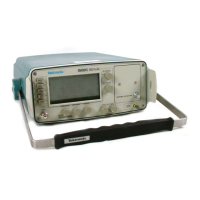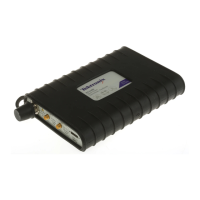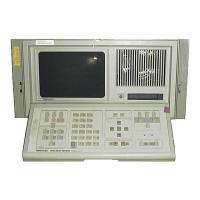Theory of Operation
4–8
1720/1721
The reference signal is ac-coupled through a tuned circuit, C791 and L791, to
drive the Chroma Amplifier, Q794 and Q795. Luminance is removed and in
normal operation the chrominance is amplified by about three times. With J796
in the 2 and 3 position (External CW Subcarrier input), the gain is changed to
slightly less than one.
The reference signal is dc-coupled to the inverting Luminance Amplifier, Q693,
which has unity gain and removes much of the chrominance. The collector of
Q693 drives the Sync Separator.
The Sync Separator strips off and processes the sync from the luminance signal
to control the timing circuitry. The Sync Stripper receives its input through
C685 and R686 into the base of Q685, a summing junction. Q685 and Q680
form an operational amplifier that inverts the sync signal and clips it near the
sync tip. Amplifier gain, which is high at sync tip time, is set by the combina-
tion of R686 (R
i
) and R682 (R
f
). During non-sync time (active video) CR680
and CR681 are both on, shunting Q680 to reduce amplifier gain and limit
saturation so that the response to the next sync transition will be rapid.
During sync time a clamp circuit consisting of Q681 and Q688 maintains the
output of the operational amplifier at about +5 V. The output is fed back to
maintain the proper level. Q681 and CR682 are a current source that is on
during sync tip. At the end of sync time, when Q680 goes low, CR682 is pulled
down and Q681 shuts off.
Q780 outputs negative-going sync that has any remaining noise greatly reduced.
The output of Q780 is fed back, through CR781, to the clamp circuit, Q688.
The Bowes Oscillator, Q880 and Q781, is triggered by the leading edge of sync.
It accepts triggers only at H intervals, during the vertical interval, to avoid
triggering on the wrong equalizing pulses. In the absence of sync the oscillator
freeruns so that sample pulses are always available for clamping. The output at
the collector of Q781 is negative-going and lasts for approximately 4.5 µs to
provide horizontal sync to the rest of the instrument.
U884A is a one-shot that provides a negative-going pulse at its output (pin 4)
that controls the sampling of burst. It is triggered by the trailing edge of sync
and its Q output (pin 13) is a 4 µs long, positive-going, back porch pulse that is
NANDed with the output of flip-flop U774B, which is clocked at a line rate.
The output of the gate (U876C, pin 8) is a negative-going pulse that occurs every
other back porch.
U646 is the Subcarrier Regenerator (Phase Lock) Loop Phase Detector. It is a
balanced demodulator, whose carrier input is driven by the VCXO CW sine
wave. Its signal input is driven by burst chrominance from the Chroma
Luminance and
Chrominance Amplifiers
Sync Separator
Bowes Oscillator
Back Porch Sample
Loop Phase Detector and
Amplifier

